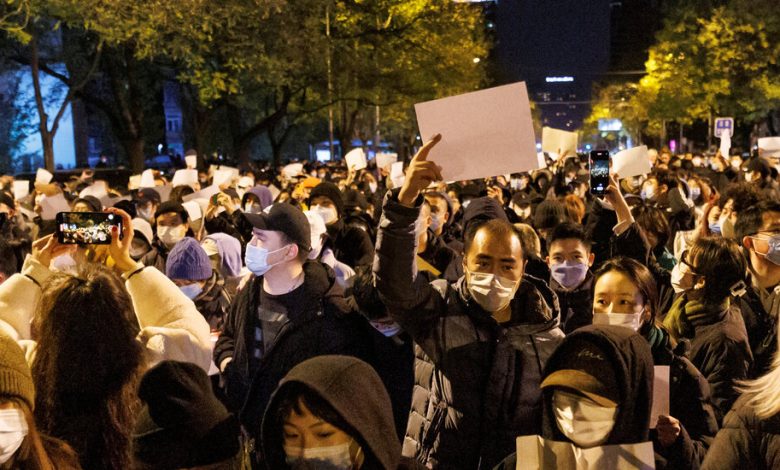The Long Odds Facing China’s Protesters

Outside observers could be forgiven for seeing hints of the Arab Spring, even revolution, in the protests sweeping China’s cities.
The demonstrations are the country’s largest and most ambitious in years, with some participants even calling for the country’s top leader, Xi Jinping, to step down.
But if protesters in China hope to bring sweeping political change, they may find that they face hurdles beyond even their government’s fearsome reputation for quashing dissent — and still tougher odds than might be apparent on the surface.
Three major forces, two of them global in nature and one particular to China, stand in their way.
For one, protests aimed at ousting a leader or government have seen their odds of success plummet in recent years, with the overwhelming majority now failing amid changes in the nature of communication, organizing and repression — a trend that China seems to fit.
For another, China’s government embodies a type of authoritarianism, known as a revolutionary government, that new scholarship has found to be exceedingly durable against even explosive unrest.
Lastly, China’s ruling Communist Party has repeatedly proven its exceptional skill at managing eruptions of popular anger, which are more common there, albeit on a smaller scale, than outside observers might assume.
The government is also especially skilled at maintaining unity among the country’s elite, which is often the deciding factor in whether protesters can force systemic change.
That does not mean the protests are doomed. Popular movements demanding an autocrat’s removal do still sometimes succeed. And there are many versions of success that do not include Mr. Xi’s departure — for example, a relaxation of the country’s “zero Covid” policies.
Still, without some of China’s elite breaking with Mr. Xi to support the protesters, William Hurst, a Northwestern University scholar, wrote on Twitter, “the most likely scenario I can see is that the protests fizzle out (as most such movements do in most countries).”
Understand the Protests in China
- The Toll of ‘Zero Covid’: The protests against China’s strict pandemic policy come after President Xi Jinping’s unbending approach hurt businesses and strangled growth.
- At a ‘Tipping Point’: For the protesters, public dissent was unimaginable until days ago. Our columnist asked young people what led them to take the risk.
- The Economic Fallout: The growing unrest in the world’s biggest manufacturing nation is injecting a new element of uncertainty and instability into the global economy.
- Reasserting Control: The Communist Party is drawing on its decades-old policy of repression and surveillance — along with some new tactics — to quash the protests.
“Having erupted spontaneously in a short period,” predicted Mr. Hurst, who studies Chinese social movements, “they will fade away without reaching any climax or denouement.”
Protests’ Waning Power
Throughout most of the 20th century, mass protests seeking a change in government grew steadily more common and more likely to succeed worldwide, felling many a dictator. By the early 2000s, two in three such movements ultimately succeeded, according to research led by Erica Chenoweth of Harvard University.
In retrospect, it was a high-water mark.
In the mid-2000s, though such protests continued to rise in frequency, their success rate began to drop. By the end of the 2010s, their odds of forcing a change in government had halved, to one in three. Data from the early 2020s suggests that it may have already halved again, to one in six.
“Nonviolent campaigns are seeing their lowest success rates in more than a century,” Dr. Chenoweth wrote in a recent paper, though this applied only to movements seeking a leader’s removal or territorial independence.
Curiously, this change arrived just as mass protests became more common, faster to rise and larger in size worldwide — a trend that China’s lightening-strike protests, stretching over multiple cities, would seem to fit.
What changed?
Social media, which enables protesters to gather in once-unthinkable numbers with little formal leadership, may paradoxically also undermine those movements, according to a theory by Zeynep Tufekci, a Columbia University sociologist and New York Times Opinion columnist.
In earlier eras, activists might spend years building the organizational ties necessary to mobilize nationally. Social media allows would-be protesters to skip those steps and spur one another to action with as little as a viral post.
The result is rallies that put thousands or millions in the street overnight — but often fizzle just as quickly.
Leaderless and decentralized, social media protests more easily fracture, especially under repression. And they struggle to coordinate strategically, a necessary step for pressing concrete demands or cultivating allies in positions of power.
At the same time, autocratic governments, learning from uprisings in the 2000s in former Soviet states, have grown savvier at outmaneuvering dissent.
Rather than resort to the overwhelming crackdowns of prior eras, which often backfired, they now undermine protests through slower, subtler methods. They spread confusion through propaganda, promote fissures within movements, contain protests and then wait them out, or apply just enough force to discourage protesters without provoking wider anger.
And autocracies increasingly cooperate and share methods across borders in what they see as a common struggle.
China has been a global leader in this, selling the technology of digital repression and surveillance worldwide. Its leaders, after all, are deeply experienced at managing protests.
Managed Dissent
Though outsiders might assume that China’s notoriously authoritarian controls have made protest unthinkable there, especially since the pro-democracy demonstrations of 1989, the opposite is true.
The country sees tens of thousands of protests every year, according to data tracked through the mid-2010s by the Chinese academic Sun Liping. Most are local, aimed at issues like pollution from a state-run plant or official corruption.
China’s leaders are thought to tolerate a hum of protest, perhaps even welcome it within limits, so as to “siphon off popular discontent without destabilizing the system as a whole,” the China scholars Vivienne Shue and Patricia M. Thornton have written.
China’s leaders know that they cannot be totally indifferent to public will. But, without genuine elections, citizens have few ways to convey their points of anger. Tolerating some protest gives leaders a way to head off dissent, and to allow citizens to feel heard, before anger boils over.
The official response is often “much less rigid and more managerial than is often presumed,” the China scholar H. Christoph Steinhardt has written, adding that the state “still tolerates a considerable amount of contention.”
A few protests have grown into something larger. In 2002, tens of thousands of workers in the city of Liaoyang rallied to demand the removal of corrupt officials who’d closed their factories. In 2011, locals in the village of Wukan expelled party officials outright, declaring a kind of autonomy and inspiring other villages to follow.
Both were initially described as major, perhaps existential, threats to Communist Party rule. The party appeared taken by surprise.
But, in both cases, China’s leaders contained the protests, allowing them to tire out. They eventually bowed to many of the protesters’ demands, even jailing the corrupt officials in Liaoyang, leading protests to gradually disperse. Then officials jailed the protest leaders, too.
Revolutionary Resilience
Why do some dictators fall to public protest and others don’t?
In a new book-length examination of every authoritarian government in the past century, the scholars Steven Levitsky and Lucan Way arrived at one major factor: how that government came to power in the first place.
Since 1900, they found, about 20 autocracies have risen out of sweeping social revolutions. These include the Soviet Union, Iran’s Islamic Republic and Communist-led China.
On average, autocracies survive about 10 years. After that, their odds of collapsing increase every year as public support erodes and as cracks widen within the ruling elite.
But autocracies founded in revolution tend to survive for many decades. Their average lifespan is impossible to state, for the simple reason that half of those to ever form are still going. The Soviet Union made it to age 69, surpassing many democracies. Iran is also, for the moment, proving surprisingly resilient against a nationwide, monthslong protest movement.
It’s not that such systems govern better. Rather, they are nearly five times likelier to survive episodes of the sort that would fell other governments, like mass unrest or a violent power struggle.
Those governments’ resilience, the scholars argue, comes from the revolution that swept them into power. Revolutionary movements typically uproot every aspect of the old order, from business leaders to officer corps to administrative bureaucracies.
As the revolution fills these out with its own, it is left with few internal rivals or threats — closing off exactly the sorts of high-level fissures that a protest movement must open in order to force a change in leadership.
Such systems are also remarkably cohesive. And disagreements or power struggles are among revolutionaries who are bought into the system and work to uphold it as is.
And revolutionary features that lend resilience, Dr. Levitsky and Dr. Way argue, are especially pronounced in China: A deeply institutionalized party bureaucracy. Internally enforced hierarchies of power. Pervasive political control of security and military forces. Deep party roots in everything from business boardrooms to local village affairs.
Even the strongest government has its breaking point. But China’s, the scholars concluded, may well be “one of the most durable regimes in modern history.”



